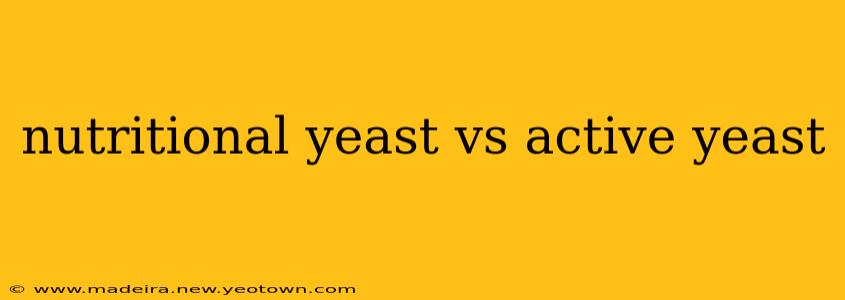Nutritional Yeast vs. Active Yeast: Two Sides of the Same Coin?
Let's unravel the fascinating differences between nutritional yeast and active yeast – two ingredients that, despite sharing a name, occupy entirely different niches in the culinary and health worlds. It's a common confusion, so let's delve into their unique properties and applications.
Imagine two cousins: one, a vibrant, energetic athlete always ready for action, and the other, a wise, contemplative sage offering health benefits in a different way. That's the essence of the difference between active yeast and nutritional yeast.
Active yeast, the athletic cousin, is a living organism, a single-celled fungus ( Saccharomyces cerevisiae) used as a leavening agent in baking. It feeds on sugars, producing carbon dioxide gas that causes bread and other baked goods to rise. This lively little microorganism is deactivated by heat during the baking process. Think of the fluffy texture of your favorite sourdough bread – that's the magic of active yeast at work!
Nutritional yeast, the contemplative sage, is also Saccharomyces cerevisiae, but it's a deactivated, inactive form. It undergoes a process that kills the yeast cells, rendering it incapable of leavening. However, this process unlocks its nutritional potential, transforming it into a powerhouse of vitamins and minerals. This inactive cousin brings a cheesy, nutty flavor to dishes, enhancing both taste and nutritional value.
What are the key differences between nutritional yeast and active yeast?
This is a common question, and the answer lies in their processing and ultimate use:
Active Yeast:
- Living organism: Contains living yeast cells capable of fermentation.
- Primary use: Leavening agent in baking; used to create carbon dioxide gas for rising.
- Flavor: Subtle, sometimes slightly yeasty, but mostly masked by other ingredients in baking.
- Nutritional value: Provides some B vitamins, but less than nutritional yeast.
Nutritional Yeast:
- Inactive/deactivated: Yeast cells are killed during processing.
- Primary use: Food supplement and flavor enhancer; adds a cheesy, nutty flavor to dishes.
- Flavor: Strong, cheesy, nutty flavor.
- Nutritional value: Excellent source of B vitamins (especially B12), protein, fiber, and other minerals.
What is nutritional yeast good for?
Nutritional yeast is more than just a flavor enhancer. Its nutritional profile makes it a popular choice for vegetarians and vegans, as it's a complete protein and a rich source of vitamin B12, often lacking in plant-based diets.
What are the benefits of nutritional yeast?
This leads us to another frequently asked question:
What are the health benefits of nutritional yeast?
Nutritional yeast is packed with nutrients beneficial for overall health. It's a good source of:
- B Vitamins: Essential for energy production, nerve function, and red blood cell formation. Especially noteworthy is its B12 content, crucial for vegans and vegetarians.
- Protein: Contributes to building and repairing tissues.
- Fiber: Supports digestive health and promotes satiety.
- Minerals: Including zinc, selenium, and chromium, which play various roles in bodily functions.
Is nutritional yeast good for weight loss?
While nutritional yeast isn't a miracle weight-loss product, its high fiber content can contribute to weight management by promoting satiety and regulating bowel movements. Its nutritional value supports overall health, which can indirectly assist in weight management strategies.
Can you use nutritional yeast instead of active yeast in baking?
Absolutely not. Nutritional yeast lacks the living organisms needed for leavening. Using it in place of active yeast will result in flat, unrisen baked goods. The two are fundamentally different in their functions.
Where can I buy nutritional yeast and active yeast?
Both are readily available in most supermarkets and health food stores. Active yeast is typically found with baking supplies, while nutritional yeast is often located in the bulk foods or health food sections.
In conclusion, while both nutritional yeast and active yeast originate from the same fungus, their processing and applications are vastly different. Active yeast leavens bread, while nutritional yeast enhances the flavor and nutritional value of dishes. Understanding these distinctions allows you to harness the unique benefits of each in your kitchen.

